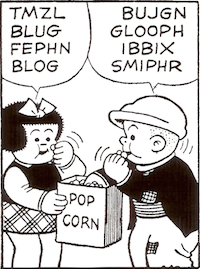Forever
directed by Heddy Honigmann
French with English subtitles
95 minutes

The simplest description of Heddy Honigmann’s Forever: a film about a cemetery, Père-Lachaise in Paris, resting place of Jim Morrison, Edith Piaf, Marcel Proust, Oscar Wilde, among many others. But the film travels elsewhere, to the Louvre, to an apartment where three sightless friends take in a Simone Signoret film (yes, she’s buried in Père-Lachaise), to Stéphane Heuet’s study for a conversation about adapting Proust into comic books, to a mortuary to watch an embalmer at work. The film, Honigmann tells a visitor to the cemetery, is to be “about the importance of art in life.” But it isn’t always: it is sometimes about death, plain and painful. The film makes room for cemetery visitors who speak of their private losses, some with equanimity, one with grief so immediate and painful that one suspects Honigmann could not have anticipated it.
T.S. Eliot, in a preface to his translation of Saint-John Perse’s poem Anabasis (1930):
The reader has to allow the images to fall into his memory successively without questioning the reasonableness of each at the moment; so that, at the end, a total effect is produced.
Such selection of a sequence of images and ideas has nothing chaotic about it. There is a logic of the imagination as well as a logic of concepts.
Forever is a film that seems to have been constructed on that modernist principle of composition by juxtaposition of elements. The elements holding the film together are many: scenes of a pianist at work, first practicing, then performing; stories of exile, from Iran and Spain; stories of forgotten poets and singers; stories from daughters of their fathers; images of flowers and water bottles; contrasts of the famous and unknown. A preternaturally young-looking old woman appears and reappears, caring for the grave sites of those whom she admires (Guillaume Apollinaire, Sadegh Hedayat, Proust). An Ingres fan in the Louvre and an embalmer in the cemetery speak in identical terms of the relationship between paintings and reality. And Honigmann joins in uncanny ways women's faces — the pianist, an Ingres portrait, a Modigliani portrait, a woman being embalmed, life and death and art blurring together.
My favorite moment in
Forever: Honigmann’s conversation with a student who has traveled from South Korea to bring cookies to Proust’s grave. Proust, he explains, has been food for his brain. He has been reading Proust for ten years, in Korean, it would seem. He has no French; Honigmann, no Korean. He struggles in English, and Honigmann asks him to talk in Korean about what Proust means to him. And the subtitles disappear. It’s the strangest moment in a strange and beautiful film.
Forever is available on DVD.
[In an interview that accompanies the film, Honigmann explains that she chose to omit a translation of the student’s remarks so that the Korean-less viewer must imagine what’s being said.]



















